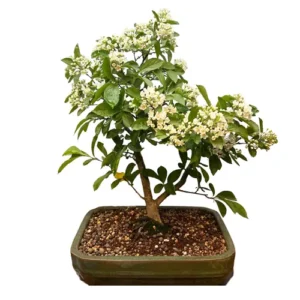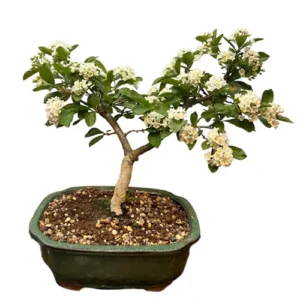Loincera
Honeysuckle Bonsai
The loincera genus is comprised of over 100 species of climbers, the nitida and pileata are favourites among bonsai enthusiasts. Honeysuckle bonsai makes for a hardy fast-growing species, displaying glossy dark green leaves atop thick distinct trunks. In spring, Loincera blossom white flowers followed by blue-purple berries.
Honeysuckle Bonsai Care Tips
Placement
Choose an outdoor location that provides full sun but can protected by partial shade in the summer, for the duration of the growing season. Honeysuckle bonsai trees are hardy but should be protected from frost during winter. If you expect consistent freezing weather consider moving it to a frost-free greenhouse, conservatory or providing insulation for the pot.
Watering
Across the growing season keep your honeysuckle bonsai watered regularly. Do not let the soil dry out. During winter, its essential to keep the soil mix just moist.
Feeding & Fertilising
Every two weeks apply a general fertiliser to your honeysuckle bonsai across the spring and summer.
Pruning & Wiring
Pruning your bonsai is important not only to create or maintain an aesthetic style but to also ensure optimal health. New shoots require continually pinching out during the growing season. Honeysuckle heals fast from cuts and hard pruning is ideally done in the summer months. Cutting back to the main trunk is an option when deemed necessary.
Honeysuckle can be wired but there is no real need as its training can all be handled through pruning. If you are to wire a branch having allowed a bud to grow out unchecked, we recommend using wires of a thickness that matches the thickness of the branch: if the wire you choose is too thick you will damage the bark. If it is too thin, it won’t be effective.
Repotting
Repotting your tree is an important way to provide a fresh and suitable soil mix and ensure appropriate root health. Repot your Honeysuckle bonsai every other year at the start of spring.
Trees that are ready for repotting will require root pruning, a suitable new pot and appropriate soil mix.
When repotting, do not cut back the root mass by a large amount, and choose a well-draining soil mix that has a neutral or slightly higher PH value of 5-6 but not over 7. We tend to use a mixture of different speciality bonsai soils on our trees. Every species is different so please contact us for free soil-mix advice or to take advantage of our repotting service.
Bonsai trees aren’t only magnificent additions to an indoor oasis, they are more than capable of standing out in any garden. Many Bonsai species are incredibly hardy and withstand nature’s colder and damper turns with aplomb making them worthwhile outdoor plants. We have an extensive library of care guides for outdoor bonsai trees. It’s not about selecting the perfect bonsai, it’s about selecting the perfect bonsai for you.
Honeysuckle Bonsai - Typical Queries
How to propagate Honeysuckle bonsai?
Honeysuckle can be propagated by seeds, cuttings or layering. Seeds need sowing in either February or March. Division should take place in Spring. Ground layer from August to November. Cuttings strike from July to August.
Are Honeysuckle bonsai prone to pests and diseases?
Honeysuckle is a relatively trouble-free plant species but aphids should still be watched out for. If they cant be removed by hand, an appropriate insecticide should help.
Can you keep a Honeysuckle bonsai indoors?
As a broad-leaved deciduous tree, this bonsai is best kept outdoors. Growing a Honeysuckle bonsai outdoors in a temperate climate should be wholly appropriate, doing otherwise may hinder growing.





















